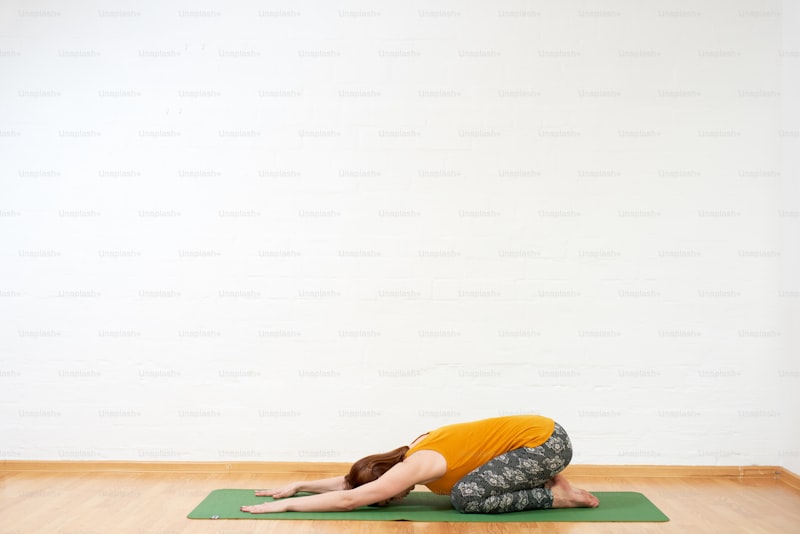At its core, yoga combines physical postures, controlled breathing, and meditation to promote relaxation and reduce stress levels. The physical aspect of yoga, known as asanas, involves various poses that stretch and strengthen muscles, improving flexibility and releasing tension stored in the body. Through regular practice, these poses not only enhance physical fitness but also cultivate mindfulness, a key component in stress reduction.
Breathing techniques, or pranayama, form another vital element of yoga practice. Deep, intentional breathing calms the nervous system, lowers heart rate, and induces a state of relaxation. By focusing on the breath, practitioners can shift their attention away from stressors, promoting mental clarity and emotional stability.

Moreover, yoga encourages mindfulness meditation, which trains individuals to observe their thoughts and emotions without judgment. This practice cultivates awareness of the present moment, breaking the cycle of worry and anxiety associated with future uncertainties or past regrets.

The holistic nature of yoga means it addresses stress on multiple levels: physical, mental, and emotional. Unlike other forms of exercise that may solely target physical fitness, yoga emphasizes the integration of mind and body, fostering a profound sense of inner peace and harmony.
In essence, yoga serves as a transformative practice that empowers individuals to manage stress effectively by nurturing a balanced lifestyle. Its enduring appeal lies in its adaptability to different ages and fitness levels, making it accessible to anyone seeking relief from the pressures of modern life.
Beyond Asanas: Exploring Yoga’s Deep Impact on Stress Relief
Have you ever wondered why yoga goes beyond just physical exercise? It’s not just about striking poses; it’s a holistic journey that profoundly impacts stress relief. Let’s dive into how yoga, beyond its asanas, truly transforms your mental and emotional well-being.
Yoga is more than stretching and bending; it’s about connecting your mind, body, and breath. When you step onto your mat, you enter a sanctuary where stress begins to melt away. Through focused breathing and mindful movement, yoga stimulates the parasympathetic nervous system, triggering relaxation responses that combat the effects of chronic stress.
Imagine your stress as a tightly wound spring. Yoga gently unwinds that spring, releasing tension stored in your muscles and mind. Each pose, from downward dog to child’s pose, encourages you to let go of physical and mental tightness, fostering a deep sense of relaxation.
Beyond physical benefits, yoga acts as a powerful antidote to the pressures of modern life. In today’s fast-paced world, stress can feel omnipresent. Yet, yoga offers a sanctuary where you can pause, breathe, and reconnect with yourself. It teaches you to be present in the moment, cultivating mindfulness that carries over into daily life.
Think of yoga as a reset button for your mind. Just as a computer reboots to clear out clutter and run smoothly, yoga refreshes your mental landscape. It encourages you to observe your thoughts without judgment, fostering a sense of calm amidst life’s chaos.
Moreover, yoga encourages self-compassion and acceptance. In a world where we often strive for perfection, yoga teaches us that it’s okay to be where we are. Each practice is a journey, not a destination, reminding us to embrace our imperfections with grace.
In essence, yoga’s impact on stress relief transcends physical flexibility. It’s about cultivating inner resilience, finding peace amidst turmoil, and nurturing a harmonious relationship between body and mind. So, next time you roll out your mat, remember: you’re not just practicing yoga; you’re investing in your well-being, one breath at a time.
This article explores the multifaceted benefits of yoga, emphasizing its transformative power beyond mere physical exercise, in a conversational and engaging tone.
From Mat to Mind: How Yoga Rewires the Brain for Stress Reduction

Ever wondered how a simple yoga session can transform your day from chaos to calm? The secret lies in how yoga reshapes our brain’s response to stress. Beyond the physical postures and deep breathing exercises, yoga has a profound impact on our mental well-being by rewiring the brain.
When you roll out your yoga mat, you’re not just stretching your muscles; you’re engaging in a practice that directly affects your brain’s neurochemistry. Studies show that regular yoga practice stimulates the parasympathetic nervous system, which helps counteract the body’s stress response. This activation leads to a decrease in cortisol levels, the hormone responsible for stress, thereby promoting relaxation and inner peace.
The mindfulness cultivated during yoga also plays a crucial role in stress reduction. By focusing on the present moment, practitioners learn to observe their thoughts and sensations without judgment. This mindfulness practice enhances emotional regulation and resilience, making it easier to cope with stressful situations both on and off the mat.
Imagine your brain as a garden: yoga acts like the gardener, gently nurturing positive neural connections while pruning away stress triggers. Over time, this cultivation results in increased grey matter density in areas of the brain involved in emotional regulation and self-awareness. These neurological changes not only improve stress resilience but also enhance overall mental clarity and focus.
In essence, yoga is not just a physical exercise but a holistic mind-body practice that promotes well-being from the inside out. It teaches us to listen to our bodies, quiet our minds, and find balance amidst life’s challenges. So, the next time you feel overwhelmed, consider stepping onto your yoga mat. Your brain and body will thank you for it.
Ancient Wisdom, Modern Relief: Yoga’s Evolution in Stress Management
In today’s fast-paced world, stress seems to be an unavoidable companion for many. Amidst this whirlwind of deadlines, responsibilities, and constant connectivity, the ancient practice of yoga emerges as a beacon of solace and rejuvenation. Originating in ancient India thousands of years ago, yoga has evolved beyond its traditional roots into a versatile tool for managing stress in our modern lives.
Yoga’s effectiveness lies in its holistic approach, addressing not only physical fitness but also mental and emotional well-being. Through a combination of controlled breathing, meditation, and physical postures (asanas), yoga encourages practitioners to connect with their bodies and minds deeply. This connection fosters a profound sense of self-awareness and inner peace, essential for combating the pressures of daily life.
What sets yoga apart from other forms of exercise is its emphasis on mindfulness and relaxation. Unlike rigorous gym workouts that primarily target physical fitness, yoga encourages individuals to slow down, breathe consciously, and be present in the moment. This mindful approach helps reduce the production of stress hormones like cortisol, while simultaneously boosting the release of feel-good neurotransmitters such as endorphins.
Moreover, yoga adapts well to various lifestyles and fitness levels, making it accessible to almost everyone. Whether practiced in a serene studio, a bustling office space, or even at home through online classes, its versatility ensures that anyone can reap its benefits regardless of their schedule or location.
Breathing Away Stress: The Science Behind Yoga’s Calming Effect
Ever wondered why yoga leaves you feeling so serene and relaxed? The answer lies in the profound connection between your breath, body, and mind. Yoga isn’t just a physical exercise; it’s a holistic practice that taps into the power of controlled breathing to alleviate stress.
At the core of yoga’s calming effect is its emphasis on deep, rhythmic breathing. This intentional breathing, known as pranayama, focuses on extending the length of each breath and synchronizing it with movements. When you breathe deeply and consciously, it triggers the body’s relaxation response. This response, governed by the parasympathetic nervous system, counteracts the stress-induced fight-or-flight response, promoting a sense of calm and well-being.
Moreover, scientific studies have delved into the physiological changes that occur during yoga practice. Researchers have found that deep breathing stimulates the vagus nerve, a key component of the parasympathetic nervous system. This stimulation releases neurotransmitters like acetylcholine and decreases the production of stress hormones such as cortisol. As a result, heart rate decreases, blood pressure lowers, and muscle tension dissipates — all contributing to a profound feeling of relaxation.
In addition to its physiological impacts, yoga’s focus on mindful breathing cultivates mindfulness — the practice of being present in the moment without judgment. By concentrating on the breath and bodily sensations during yoga poses (asanas), practitioners enhance their awareness and develop mental clarity. This mindfulness aspect of yoga further aids in stress reduction by redirecting attention away from worries and anxieties.
In essence, yoga’s ability to alleviate stress isn’t merely anecdotal; it’s supported by scientific evidence. Through the combination of deep breathing, physiological changes, and mindfulness cultivation, yoga offers a holistic approach to stress management that promotes both physical and mental well-being. So next time you roll out your yoga mat, remember: each breath you take is a step towards a calmer, more relaxed you.
Frequently Asked Questions
Which yoga poses are best for managing stress?
Discover effective yoga poses that help manage stress with this concise guide. Learn about poses like Child’s Pose, Forward Fold, and Corpse Pose, proven to promote relaxation and reduce stress levels effectively.
Can yoga be combined with other stress management techniques?
Learn how to effectively combine yoga with other stress management techniques to enhance relaxation and overall well-being.
Is yoga suitable for everyone seeking stress relief?
Yoga can be beneficial for stress relief for most individuals. However, it’s essential to choose appropriate styles and modifications based on individual health and fitness levels. Consultation with a healthcare provider may be advisable before starting.
How does yoga help reduce anxiety and promote relaxation?
Discover how yoga can effectively reduce anxiety and promote relaxation through a combination of mindful breathing, calming postures, and meditative practices. By fostering a sense of inner peace and reducing stress hormones, yoga cultivates a state of mental clarity and physical relaxation, making it a powerful tool for managing anxiety and improving overall well-being.
What are the benefits of yoga for stress relief?
Discover how yoga can effectively reduce stress levels by promoting relaxation through mindful breathing, stretching exercises, and meditation techniques.


